Is a Dislocated Shoulder Likely to Happen Again
A dislocated shoulder occurs when the humerus os is displaced forrad out of the joint. Here nosotros explain the symptoms, causes, and rehabilitation for shoulder dislocations.
Dislocated shoulder symptoms
Symptoms of a shoulder dislocation include:
- Sudden astringent pain will exist felt at the time of injury.
- Your shoulder joint will swell up rapidly
- Bruising usually develops later.
- You may feel your shoulder has popped out of the articulation.
The injured side will often expect different or peradventure lower than the uninjured side.
The patient may concur their arm close to their body and resist moving or turning it outwards.
If there is whatever nerve or claret vessel damage, you may besides feel pins and needles or numbness.or discoloration through the arm to the hand.
If you suspect a confused shoulder, seek immediate medical attention. DO NOT endeavour to put the articulation dorsum into place as long term damage can be caused.
What is a shoulder dislocation?
A confused shoulder occurs when the head of the humerus (upper arm) bone pops out of the shoulder joint.
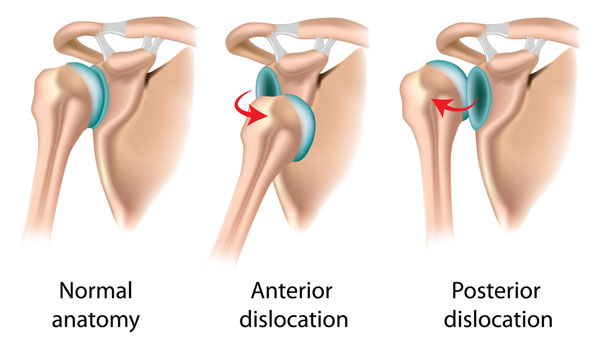
They are unremarkably either posterior or inductive dislocations:
Anterior shoulder dislocations
About dislocated shoulders are inductive dislocations. They occur in approximately 95% of injuries.
The head of the humerus bone dislocates forrard, out of the front of the joint.
In particular, they occur when the arm is out to the side (abducted) and rotated outwards (externally rotated).
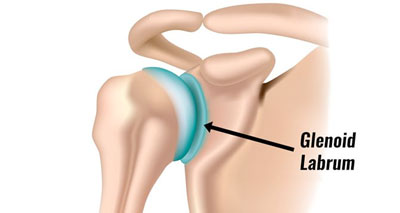
Most shoulder dislocations besides cause tears to the glenoid labrum. This is a ring of cartilage which acts similar a loving cup, in which the humerus bone rests. This is known as a Bankart lesion.
Anterior shoulder dislocatins are also associated with Axillary nerve injury, especially if there is whatsoever impaired sensation/numbness over the outside of the shoulder.
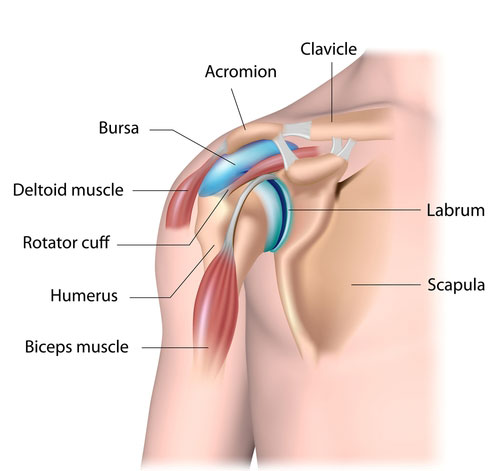
If you accept dislocated your shoulder and then you are likely to have impairment to the surrounding ligaments, tendons, nerves, blood vessels and fractures to other bones.
Recurring injuries can be common which is why it is especially important to do sufficient shoulder rehabilitation.
Posterior shoulder dislocations
The head humerus dislocates out of the dorsum of the joint.
Posterior dislocations account for effectually 3% of shoulder dislocations and can occur during epileptic seizures or when falling onto an outstretched hand.
- More on Posterior shoulder dislocation
Dislocated shoulder causes
Dislocated shoulders are usually caused by falling onto an outstretched arm, twisting your arm, or a direct affect to the shoulder.
The shoulder joint is particularly prone to injury due to the large range of motion bachelor. The increased range of move sacrifices joint stability. Therefore making the shoulder more than susceptible to injury.
Treatment
Immediate treatment for a dislocated shoulder has two stages. First protect your shoulder articulation to prevent farther damage and secondly seek medical attending as soon as possible.
Do non attempt to pop the shoulder back in yourself. Serious harm can occur to nerves and other blood vessels if it is washed incorrectly.
Immediate First Aid
Stop play immediately and seek medical attending. It is likely you will non accept a option about this, as a dislocated shoulder is very painful.
A doctor will need to confirm your shoulder is confused and put it back into its socket. This is known as reduction.
Cold therapy/ice
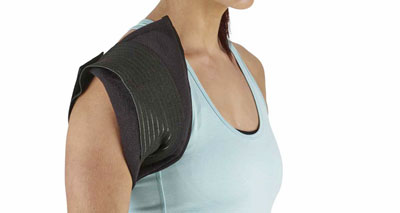
Apply ice or cold therapy. Ice can exist applied for 15 minutes every hour to aid with the pain and swelling.
Specialist cold therapy shoulder wraps are particularly practiced as they apply both common cold therapy and compression at the same time.
Protection
If a Md cannot perform a reduction immediately, they may utilise a sling to take the weight off your arm. Later, after the initial acute catamenia a shoulder brace/back up helps to restrict unwanted joint movement.
Dislocated shoulder reduction
Reduction is the medical term used to describe relocating a confused bone dorsum into the right position. The sooner your shoulder is reduced, the easier information technology volition exist to reduce it.
This tin can exist done without surgery, called a closed reduction, or surgically, known equally open reduction. The conclusion of whether to surgically reduce your shoulder may depend on any associated injuries, fractures and damage to your articulation.
Reduction should ever be followed up with a post-reduction 10-Ray to check for whatsoever possible complications.
Your medico may requite you an injection of 10-15ml of xylocaine to reduce hurting, muscle spasm and therefore assist reduction.
Surgery
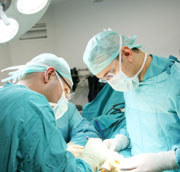
If surgery is indicated, information technology is usually performed as soon equally possible after your injury.
Patients aged 15 to 25
In particular, evidence also suggests that young, active adults between the ages of 15 and 25 would benefit from surgical reduction for a first time anterior dislocation. The recurrence rate and quality of life outcomes appear to be better than for nonsurgical reduction.
Patients aged 25 to 40
Patients anile 25 to xl may be recommended a catamenia of conservative treatment first every bit recurrence rate is lower for older patients.
There are a number of procedures which can be performed. The decision over which process to use depends largely on the patient's lifestyle and activity.
Some procedures effect in reduced shoulder external rotation and then are not suitable for athletes involved in throwing or racket sports as this would impact performance.
Recurrent shoulder dislocations
Unfortunately, recurrent dislocations are frequent, especially in younger athletes. Oftentimes arthroscopic surgery is done to investigate the damage washed and/or stabilize your joint.
If a Bankart lesion is plant then this should be repaired. The chance of suffering some other dislocated shoulder is reduced to less than five% following surgical repair.
Handling after reduction
Treatment following a closed reduction is often referred to as conservative treatment. It ways non-surgical and usually involves a period of rest and immobilization in a sling or similar.
This is to let the structures which may take been injured to have acceptable time to heal.
Some surgeons will advocate immobilizing your shoulder in 30 degrees of external rotation. This is because using a traditional sling in internal rotation (beyond your forepart), can brand a Bankart lesion worse.
Although it may exist very inconvenient, immobilising at 30 degrees can reduce the run a risk of your injury recurring.
You may be prescribed NSAIDs such every bit ibuprofen to ease pain and inflammation.
Dislocated shoulder rehabilitation
Your shoulder will demand extensive rehabilitation to regain mobility and strength.
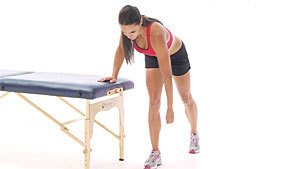
Following a reduction, you will normally be brash to residuum and immobilize your shoulder in a sling for 5-7 days, longer if there are fractures or astringent soft tissue harm.
Afterwards the period of initial immobilization, exercises to gradually increase your range of pain-free move are washed.
Eventually isometric strengthening exercises, dynamic strengthening, proprioception and functional or sports related should be done.
- More than on Dislocated shoulder exercises
References
- Smits-Engelsman B, Klerks One thousand, Kirby A. Beighton score: a valid measure for generalized hypermobility in children. J Pediatr 2011;158(i):119–23, 123.e1–4.
- Gagey OJ, Gagey N. The hyperabduction test. J Os Joint Surg Br 2001;83(ane):69–74.
Source: https://www.sportsinjuryclinic.net/sport-injuries/shoulder-pain/acute-shoulder-injuries/dislocated-shoulder
0 Response to "Is a Dislocated Shoulder Likely to Happen Again"
Post a Comment